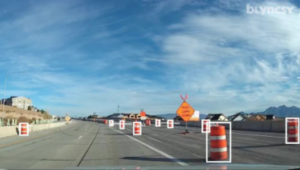Blyncsy's Collaboration with The University of Utah's Deep Learning Certificate Program
The University of Utah's Deep Learning Certificate Program is collaborating with Blyncsy to help students develop deep technology talent. Part of the R430, Deep Technology Initiative, students are utilizing Blyncsy Cloud to apply artificial intelligence and new techniques to push the boundaries of transportation system management.

Accurate road damage classification and detection is one of Blyncsy's major goals. Research in this area informs maintenance priorities and enables more efficient and safer remote monitoring of pavement conditions. Students, using Blyncsy Cloud, are developing new methods and research in this area.

Students are improving detection and classfication of construction Barrels in crowd-sourced dashcam imagery using the latest Deep Learning methods and Blyncsy Cloud.
Six students were split into two teams and worked on representative problems from industry that could be solved using Deep Learning techniques.
Road Cracking Group
Adithya Badidey, Ryan Dalby, Zhongyi Jiang
April 29, 2022
For their deep learning capstone project, these students addressed concerns of road cracking by approaching the problem of road crack detection and size estimation using deep learning-based computer vision techniques on dash cam imagery. Combined with the large-scale availability of real-time dash cam imagery they hoped to enable the creation of real-time geospatial maps that can be dynamically updated with incoming data. Students could detect:
1. D00: Longitudinal crack
2. D10: Lateral linear crack
3. D20: Alligator crack
4. D40: Potholes
Sign Detection and Dashcam Image Classification Group
Michael Sieverts, Yoshihiro Obata Mohammad Farhadmanesh, David Scharny, and Thomas C. Henderson
Traffic sign detection and classification is a task performed manually all over the world to ensure proper road safety and regulation. Performing this task manually is a slow process and performed infrequently. Deep learning has high potential in this field because of the abundance of dashcams on the road today. This group used deep learning to detect and classify signs from dashcam images. They used a two-step process, a detection network that detects the signs in the images and a classification network that takes the bounding box from sign detection to assign a specific sign class from over 600 classes of signs. Real labeled data from Tennessee dashcams is used to train the detection network, and a combination of real and synthetic data is used to train the classification network. Their image classification pipeline performs well given the low amount of real data supplied to the networks, especially for classification where each class little to no real data. On a withheld test dataset from Utah dashcams, they obtained a detection accuracy of above 80% on large signs and a classification accuracy of about 50% on all signs. While the present work could be improved with more training data and more accurate classes during labeling, results show the high feasibly for an image classification pipeline using the two-step deep learning approach shown in this work.